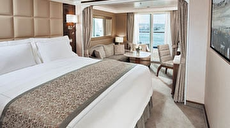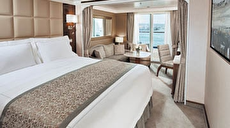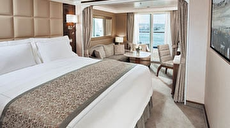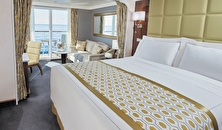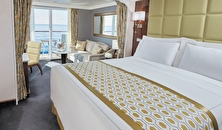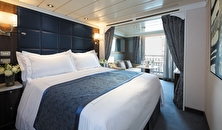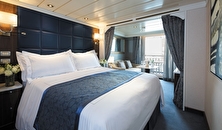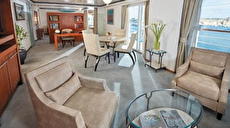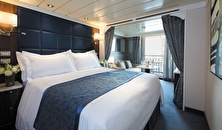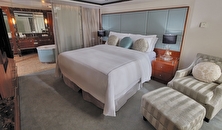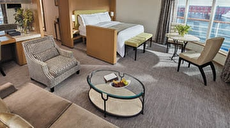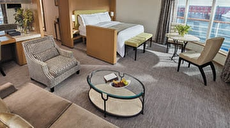
Regent Seven Seas Cruises - Seven Seas Voyager
Line:
Regent Seven Seas CruisesLaunched:
1st March 2004Tonnage:
42,363Length:
204 feetTotal Crew:
455Occupancy:
698Rating:





 stars
stars
Description
A trailblazer in the exclusive world of all-suite, all-balcony ships, Seven Seas Voyager exceeds even the loftiest expectations for luxury. Considering her size, the amenities are surprisingly plentiful and include four main dining venues where you can dine wherever, whenever and with whomever you choose. With 447 international crew members attending to a maximum of but 700 guests, personal service is exceedingly indulgent throughout.
You’ll find time spent on board the ship to be just as enriching as time ashore. Relax by the pool, compete in a friendly game of trivia or bocce ball, indulge in treats at afternoon tea and gain insight from an expert lecturer.
Cabin Types
Entertainment
Cigar Bar TheatreFitness
Aerobics/Yoga Fitness Center Gym Jogging TrackFood and Drink
Compass Rose Restaurant La Verandah Buffet Poolside Grill Prime 7 Signatures RestaurantOther
Boutique Laundry Service Observation Lounge Photo Shop Shore Excursion OfficeRecreational
Golf Nets Library Nightclub Outdoor Pool Shuffle Board Table TennisRelaxation
Beauty Salon Sauna Spa Steam Room WhirlpoolCruise Line
Regent Seven Seas Cruises provides An Unrivaled Experience™ to luxury travelers with a five-ship fleet that visits more than 450 destinations around the world. The final phase of Regent Seven Seas Cruises’ $150 million fleet-wide refurbishment was recently completed, elevating the elegance of its fleet to the standard set by the all-balcony, all-suite Seven Seas Explorer®, which entered service on July 20, 2016. Seven Seas Explorer is joined by all-balcony, all-suite sister-ships Seven Seas Voyager®, Seven Seas Mariner®, and all-suite, 90 percent-balcony Seven Seas Navigator®. Seven Seas Splendor™, the ship that defines luxury perfected, joined Regent’s fleet in early 2020.
With headquarters in Miami, Regent Seven Seas Cruises® is owned by Norwegian Cruise Line Holdings Ltd., a diversified cruise operator of leading global cruise lines Norwegian Cruise Line, Oceania Cruises and Regent Seven Seas Cruises®. These brands operate a combined 27 ships with approximately 58,400 lower berths visiting more than 450 destinations worldwide. The Company will introduce ten additional ships through 2027.
Norwegian Cruise Line Holdings Ltd. is committed to environmental conservation. The company’s global environmental program, ‘Sail & Sustain’, reflects the Company’s mission of providing truly exceptional cruise vacation experiences for all of its guests, while also minimizing its impact on the environment.
Ships
Seven Seas Explorer, Seven Seas Grandeur, Seven Seas Mariner, Seven Seas Navigator, Seven Seas Prestige, Seven Seas Splendor, Seven Seas Voyager
Seven Seas Voyager 




Regent Seven Seas Cruises
Average Ship Rating
customer reviews
- 5 Star : ( 1 )

- 4 Star : ( 0 )

- 3 Star : ( 0 )

- 2 Star : ( 0 )

- 1 Star : ( 0 )

“Review of Newly Refurbished Seven Seas Voyager”
Staff Member recommended this ship.





Rosemary and I were very fortunate to be given the opportunity of sailing on the newly refurbished Seven Seas Voyager as guests, which gave us the opportunity to see and judge at first hand the changes after the recent multi-million refurbishment of both Voyager and her sister ship the Seven Seas Mariner.
$40 million dollars was spent (the largest investment on existing tonnage ever made by RSSC). This includes: new lounge and dining areas, including upmarket loungers and furniture around the Pool Grill; new carpeting, wallpaper, upholstery, light fixtures, and drapes in public areas and suites. And an extended coffee/tea and snack bar with cakes, sandwiches, cheese, fruit etc open 24 hours.
We feel that Regent have got it right – First class accommodation, inconspicuous service throughout the ship (no annoying over the top stuff), food is the best ever tasted, with simple and sophisticated options. The best orchestra at sea, in a spacious theatre, or one of the three lounges, a good variety and standard of entertainment.
These two Regent ships are arguably the best in the world. Regent offers unbelievable space for just 700 guests and Voyager and Mariner are the only two ships in the world to offer every guest an outside suite with balcony. Not only are all the suites very spacious, but corridors, open decks and the open spaces that connect public rooms and restaurants are extremely wide in many areas.
Those planning large multi-stream cruise ships would be horrified at the amount of wasted space! One of the important ingredients that Regent offers is space and a feeling of calmness, which is important to potential guests who live in a stressful, complicated and over busy world. At the time of refurbishment many of the lounges and public rooms were re-designed to create more spacious areas for relaxing. Most of these improvements and refurbishments were based on extensive feedback from Regent’s loyal client base and many have already remarked that the ships are looking better than when they were originally built back in 2001 and 2003. We would totally agree.
A new restaurant was also introduced: a steakhouse called Prime 7. A fresh, contemporary interpretation of a traditional grill. More about this later.
Guest lecturer on board
Another important part of our cruise was the guest lecturer on board, Sandra, who had worked for the BBC on many occasions. She gave several one hour extremely professional PowerPoint presentations in the main theatre at appropriate times through the cruise.
These included: The History of the Baltic and the USSR; ‘The Great Russian Composers’; Scandinavian countries ‘From the Vikings to Abba’ and an amusing one on ‘The True Story Of Hans Christian Anderson’
This important facility is not always recognised and could be an important attraction for future clients. Regent guest lecturers are always of the highest standard and have in depth knowledge of the areas the itinerary includes. This is in addition to the regular lectures made by Regent shore Excursion personnel. All lectures can be viewed later on TV monitors in suites.
Some of you may recognise bits of this report which have been transposed from a previous report I did on the Voyager while travelling on a previous occasion.
The suites are extremely spacious and well equipped. Lead-in categories are still around 300 sq ft, large queen bed or large twins beds, separate sitting area, (seating up to 5 comfortably) with stocked fridge, bathroom probably larger than the one at home with separate bath as well as shower. Large veranda and a walk in cupboard with massive hanging space and safe. Staff kept the suite scrupulously clean – we went for breakfast and it was ready when we returned. Cleaned again in evening.
The food was the highlight of the trip: the lamb, sole, salmon, goose and turkey stand out in my mind as being the best I have tasted – cooked to perfection no matter which restaurant we were dining in.
Which reminds me to explain the dining experience and options on board in more detail. The two larger ships the Voyager and Mariner are similar. The Veranda Café serves buffet breakfast and lunch. This is no ordinary café, it is carpeted, good décor, spacious, with proper table cloths and napkins, coffee and pots of tea (as well as any other drinks) served to your table. Eggs etc are cooked to order and delivered to your table fresh. For anyone with walking difficulties there are more than enough staff to assist. Although this is the café, the food quality is as good as the rest of the ship.
One side of the Veranda Café is turned into an intimate Bistro in the evening. The food and service are first class and smart casual wear is the order of the day, also in an evening. Most of the courses are waiter service; however there are exciting antipasti at the buffet. The sweets are all mainly at the buffet apart from the flambé (different fruits each evening) and ice cream – the cherry one is to die for.
The main restaurant, The Compass Rose, opens for more formal dining at breakfast, lunch and dinner, and will accommodate over 500 people. It has a wonderful selection of food with simplicity selection and healthy options as well as a comprehensive menu changed regularly. The new colour scheme in the restaurant is outstanding – the Chablis and Merlot palettes have certainly given the restaurant a very warm and appealing feeling.
The Cordon Bleu Restaurant, Signatures, (reservations mandatory and can be booked online 30 days before sailing) offers a wonderful culinary experience with plenty of choice. You would only visit this restaurant once on a one week cruise – menu stays the same for one week. Remember no supplements for any dining option and drinks and wine included at all times. The rack of Lamb and the warm chocolate pudding with chocolate ice-cream were wonderful – as well as the beef. Service levels very high in this intimate restaurant. The bold new jewel colours fitted well in this restaurant giving it a unique upmarket feeling.
New Prime 7 Restaurant (replacing Latitudes Asian Fusion – reservations mandatory again). A specially created menu features prime-aged steaks, chops, seafood and poultry. Options include steaks on the bone, New York slow roasted prime rib, fine filet mignon and Porterhouse steaks carved at the table. Surf & Turf, filet mignon steak and Canadian coldwater lobster tail or Alaskan king crab legs, all very popular, are also available. For those who do not fancy steaks the menu includes New Zealand lamb chops (which I can personally recommend as the best), Korobuta Berkshire Pork Chops and oven roasted organic chicken or Maine Lobster. This restaurant proved very popular on the cruise and was full most evenings. There again, it was only created (and its menu) in close consultation with Regent past loyal guests. This is not your ordinary steakhouse on a cruise ship, if you are at all familiar with the standards that Regent offers with their food and experience at any level.
The evening we dined there the food and service could not be faulted –Rosemary had the organic roasted chicken and I had the lamb. The steaks being served to others looked wonderful but we would have asked for half portions! The general feedback from clients has all been very complimentary.
Over recent years the level of spend on food by Regent has increased and it is recognised by the trade as one of Regent’s strong selling points.
The Pool Bar Grill was open most of the day serving delicious snacks, lower swimming pool deck never too busy and the upper deck totally uncluttered without any loungers.
Third Ship to be totally refurbished Regent’s third smaller ship the Navigator (carrying only 500 guests) has only 2 main dining options but again the choice and standards are superb. A similar major refurbishment of this ship will take place at the end of the year (2009) and will include introducing the highly successful Prime 7 restaurant to this vessel. We will keep you informed of developments.
Dress Code
Regent are simplifying their dress code for 2010 by having only two types on an evening: formal and country casual (smart casual). I have included the official document at the end of this report. Having travelled with Regent on several occasions this makes total sense, since most guests make an effort in an evening to wear attractive clothing whether it is formal or more casual.
Many women use wraps or jackets in an evening due to the air conditioned environment and men have casual jackets or smart shirts on non formal evenings.
Remember there are no supplements for any restaurants and drinks, wine and gratuities are included. All the ships have outside suites starting at around 300 Sq Ft and most have balcony (Voyager and Mariner have all balconies and 90% on Navigator have balconies).
Exciting new 2010 Itineraries for all ships
The fully refurbished Seven Seas Voyager & Seven Seas Mariner are, for the first time, offering longer itineraries to the Baltic, Scandinavia and Mediterranean during the summer of 2010.
Seven Seas Navigator inaugural Spring sailing after her restyle will be through the Panama Canal before starting her first ever Alaska season. (She may have an extra couple of sailings prior to this now – we will advise you in due course). Carrying only a maximum of 490 guests she will be well suited to offering a more intimate luxurious experience for discerning travellers who want to visit Alaska. See list of latest brochures and offers at end of report.
A Short note on ports of call for those who are interested.
Gothenburg
Sweden’s second city and largest seaport was strongly influenced by the Germans and the Dutch – confirmed by the many canals and old merchant houses found in the old town.
The compact town lying close to the Gota River and crisscrossed with many canals had a ‘small’ town feel about it; much of it pedestrianised with many attractive shops and cafes as well as a well patronised efficient tram system. The many attractive older buildings with fine architecture, set in sometimes very wide streets, were occasionally interspersed with not so attractive 1960s vintage buildings – however not nearly as ugly as some of the buildings we have inherited in the UK.
The shuttle bus from the dock area took around 20 minutes crossing the Gota River and past the various Ferry Terminals (close to the old town) and dropped us at the Town Hall (Rudhuset) – an attractive old building with a controversial modern extension.
Rosemary and I had time to walk down the pedestrianised Vastrahamngatan walking back up the very wide main street – the Kungsportsavenyn. Taking a boat trip up and down the canals seemed a sensible way of seeing much of the town.
We were both pleasantly surprised with Gothenburg but it is not a destination to stay long at because of costs.
Warnemunde – Germany
We stayed at Warnemunde for the day as the weather was disappointing –the small town and promenade is only about 5 to 10 minutes walk from the pier.
It was one of the main seaside resorts for East Germans and has a slightly run down feel about it. Quite a few tourist shops, beach and lighthouse. You might not want to spend the whole day here. Taking a trip to Rodstock in the morning is a better option.
For those who do not fancy taking the long transfer to Berlin for the day a good alternative is to take the train to the ancient town of Rodstock; trains run every hour and take about half an hour. I believe on arrival at Rodstock Hbf you need to take a tram into central Rodstock which leaves from an underground station below the main railway station.
Alternatively you can take a pleasure boat trip to Rodstock which takes about an hour each way including a tour. The boats leave from beside the cruise terminal and the railway station is close by.
Gdansk
Prior to 1945 Gdansk was known as Danzig and most residents were Germans. The first shots of World War II were fired here on the 1st September 1939 which started the destruction of Poland with many millions left dead.
Most of my generation think of Solidarity when Gdansk is mentioned – the famous strikes of workers from the former Lenin Shipyards in the 1970s against food price increases; led by the famous Lech Walesa. The government of the time was eventually forced to recognise the first independent Trade Union in the former Soviet Bloc.
We took the shuttle coach from the port to the old town (around 25 minutes) in pouring rain – we did carry on despite the downpour and we were rewarded. The old medieval town of Gdansk is absolutely beautiful – mostly pedestrianised with cobbled streets. Most of the many old buildings have been beautifully restored in the old town; in total contrast to the rest of the Gdansk area which looked much ‘run down’ with 1960s buildings and infrastructure and the old ship yards in the distance.
The rain stopped and some sun revealed the many interesting features of the medieval buildings.
We had the mandatory coffee break and joined the locals at a wonderful café
Maraska Marek Krzoska, Ul. Deluga 31-32 (Main st), cost £6 for two coffees and a cake. Most shops will take Euros but cafes prefer the local currency. See currency conversions at end of report.
Places to visit in the Old Town; most are all within walking distance of one another are:
The Prison Tower
The Golden Gate
The Armory
The Town Hall
The Fountain of Neptune
St Mary’s Basilica
The Crane (Krantor)
The Green Gate
St Nikolas’ Church
St John’s Church
St Elizabeth’s Church
St Brigid’s Church
St Catherine’s Church
The Grand Mill
The Old Town Hall
Monument to the Fallen Shipyard Workers (Pomnik Poleglych Stoczniowcow)
Places in italics 10 minute walk apart from Monument which is much further away.
Klaipeda - Lithuania
One of the few ports that remains ice free year round in the Eastern Baltic.
Much of the town was damaged during World War II and many of the already damaged churches were demolished by the Russians afterwards. A 5 minute shuttle bus ride from the pier takes you to Theatre Square. Close by are many of the historical half timbered buildings.
The place seemed deserted when we were there; the weather did not help and maybe Klaipeda is not quite ready for the tourists. Reminded me of what our town centres used to be like on Sundays when shops did not open.
We walked to the Clock Museum (tells the history of timekeeping), about 15 minutes from Theatre Square, to find it did not open until the afternoon so gave up on that one. Not many of the locals seemed to know where it was.
We did notice however (what seems an eastern Baltic custom) padlocks secured to the iron fences of bridges with inscriptions engraved on them. Many of the shops and stalls take euros but there again I would imagine cafes would want the local currency if you can find one open.
If returning to Klaipeda I would concentrate my efforts on visiting the older historical area and museums around Theatre Square and possibly visit the Clock Museum (15 minutes walk away) later on in the day after checking opening times. You also pass the The Arch after you cross the Dane River which commemorates the joining of Klaipeda to the rest of Lithuania.
Riga – Latvia
Riga was my favourite port, apart from St Petersburg, despite the pouring rain. I was sad to hear of the disruption and destruction caused by ‘stag’ party trips recently, which the mayor and others are desperately trying to solve.
Riga’s old town is about 20 minutes walk along the river bank from the ship – a pleasant walk if dry – we should have taken a taxi.
At the crossroads between East and West Europe, Riga has wonderful architecture and long twisting avenues.
It has inherited Jugendstil Architecture (German form of Art Nouveu); rich in detail with many of the buildings constructed in the early 1900s.
The city has an upmarket feel (despite the Stag party image) about it, completely different from its neighbours – high quality shops, restaurants and hotels abound.
Rosemary and I found a wonderful traditional bakers and coffee shop (Smilsu Pulkstenis, Kalku 7) - 2 coffees and one cake £5. There again cafes want local currency but shops take Euros as well.
We enjoyed walking around the many streets admiring the architecture and were fortunate enough to catch a 45 minute organ recital at the Dome Cathedral at Dorma Square. Cost £5,
Notable places to visit most all within walking distance of one another are:
The Dome Cathedral ( Doma Square)
St John’s Lutheran Church (Skarnu Street)
St. Jacobs Catholic Church (Klostera Street)
St Peters Lutheran Church (Skarnu Street)
The Small & the separate Great Guild (both Amatu Street)
The Melngalvju (Blackheads) House (Townhallsquare)
The Gunpowder Tower (Smilsu Street)
The Three Brothers - Medieval Residence (Maza Pils Street)
The Freedom Monument (between Brivibas and Raina Boulevards)
Tallinn – Estonia
Tallinn is said to be the quickest growing Baltic Capital; although formerly part of the USSR, you are reminded more of its medieval past when you enter the town. It still retains 20 of its original 46 towers built in the middle ages and many sections of the old wall are still intact.
You can walk to the old town from the various piers – around 10 minutes depending on where you dock. We took the shuttle bus so as to preserve our energy for the walk round the lower and upper old town.
The main square is Town Hall Square (Raekoja Plats) where executions used to take place; on one side of the square lies the imposing town hall with its vaulted halls. Avoid the cafes and restaurants in the square (they have these annoying vendors plying for trade – the first and only we saw in the Baltic). There is a good craft Market in the square. Take one of the streets leading to the upper town up towards the beautiful Alexander Cathedral.
We stopped at a lovely coffee shop more off the beaten track between the lower and upper town called Matilda Café 2 - coffees and one cake around £4 (70 Kroon).
Notable places to visit all within walking distance of one another are:
St Mary’s Cathedral, Alexander Nevski Cathedral, St Olaf’s, St Nicholas, Holy Ghost Churches
Toompea Castle
Tall Hermann Tower
Town Hall
Kiek in de Kok Tower
Catherine’s Passage
Museums - Tallinn City. Estonian National Art, and Estonian History.
St Petersburg
St Petersburg was definitely the highlight of the trip for both Rosemary and I. Known as the ‘Venice of the North’ (not Stockholm as I thought which is known as ‘Beauty by the water’), with its network of waterways and canals branching off the wide Neva River. Founded in 1703 by Peter the Great, its name has changed three times: Petrograd (1914) Leningrad (1924) and then back to St Petersburg (1991).
Many of the rather grand classical and baroque buildings, palaces and churches have been beautifully restored; the city reminded us of both Vienna and Venice – two cities we loved.
The most famous of the ‘sights’ is the 4000 room Winter Palace where the October Revolution started and finished. Swathed in malachite, jasper, agate and gilded mirrors, this famous palace was the residence of Russia’s rulers from Catherine the Great (1762) to Nicholas 11 (1917). The palace houses the State Hermitage Museum and three other portions are the gallery of the 1812 – Portraits of the 1812 War Heroes. The gold-trimmed green and white palace houses one of the World’s finest art collections begun when Catherine bought 255 paintings from a Berlin art dealer. Many of the best known artists of the European Renaissance and pre-renaissance periods are represented in the collection which now number over 3 million works.
Our particular cruise enjoyed 2 nights stay in St Petersburg (Regent normally offer 3 nights).
Morning Highlights Tour of St Petersburg.
The first day we chose the morning Highlights tour which was ideal as we saw (and photographed) many of the beautiful buildings and architecture. Our first stop was at the The Strelka which gives marvellous views over the Neva River including the colourful buildings and the Winter Palace.
Close by is the Russian battleship Aurora which became a symbol of the Russian Revolution when on 25th October 1917, her crew joined the Bolsheviks and refused an order to take to sea. At 9.45 pm on that date, a blank shot from her forecastle gun signaled the start of the assault on the Winter Palace, which was to be the last episode of the October Revolution.
We continued to the Peter and Paul Cathedral, which lies within a fortress across the Neva River. It is the oldest church in St. Petersburg, and also the second-tallest building in the city (after the television tower). It is home to the graves of nearly all the rulers of Russia since Peter the Great. The Cathedral itself marked a radical departure from traditional Orthodox churches, being built in early Baroque style. The graves of the former rulers and their families from Peter the Great onwards, are very extravagant, and well worth seeing.
One of the many areas we passed was The Field of Mars; a large park and square in the centre of St Petersburg. Named after the Roman god of war, the field was the setting for military parades and drills for imperial guards’ regiments.
During the 1917 February Revolution many people were killed here which led the Bolsheviks to construct the existing memorial and eternal flame and to rename the field to ‘Victims of the Revolution Square’.
We finally ended up at the famous Church of Our Savior of the Spilled Blood. This marvellous Russian-style church was built on the spot where Emperor Alexander II was assassinated on March 1 1881. Constructed between 1883 and 1907, the church was designed in the spirit of 16th and 17th century Russian architecture, inspired particularly by St Basil's Cathedral on Red Square in Moscow. The interior of the church, a memorial to the late Emperor Alexander II, was decorated with different shades of marble and several thousand square yards of mosaic. Today, the church's onion domes have been newly gilded and its interiors painstakingly restored to their former glory. There are also lots of souvenir stalls nearby eager to take your euros, Dollars or local currency. This area was obviously where all the tourist coaches end up and the site was rather spoilt by this aggressive vendor activity!
St Petersburg – An Evening of Russian Ballet (first evening)
We had a rest in the afternoon before going to the Russian Ballet in the evening at the Palace Theatre performed by the Saint Petersburg Theatre Russian Ballet. None other than Tchaikovsky’s Swan lake. The main cast were on tour but the prize-winning understudies were wonderful; an excellent performance.
St Petersburg – Canal Cruise & shopping (second day in afternoon)
We chose to take the afternoon boat trip on the River Neva and the many canals and waterways. – giving us the opportunity of having a relaxing morning on the ship.
This trip was wonderful and I strongly recommend it – a great way of viewing all the wonderful architecture. The particular guide we had was very friendly and not afraid to talk about the changes since Perestroika. The trip included cruising the Moika River, the Neva and the Fountain River. There are many beautiful extremely low bridges including the Anichkov Bridge famous for its bronze sculptures of wild horses and the Lomonosov Bridge with its unusual stone turrets. You had to be careful not to stand upright on the open air section of the boat; no health and safety rules here! The array of buildings viewed included the Yusupov Palace, the Baroque masterpiece Stroganov Palace, the Church of Our Savior of the Spilled Blood, and the imposing St. Michael's Castle. Time was left at the end for some shopping at the aptly named Red shop which offered free shots of vodka and coffee with a good selection of souvenirs.
St Petersburg – Other Places of Interest worth visiting
We did not have time to view the Hermitage (obviously if we had the 3 days of the normal Regent itinerary cruise we would have). I believe an internet site will eventually be available to view most of the works.
St Catherine’s Palace and park, 12 miles outside of St Petersburg is well worth a visit. Peter the Great presented the palace and estate to his wife Catherine in 1712. It was almost completely destroyed by the Nazis during the Second World War (57 of the massive halls were totally destroyed). Although the Nazis did not take Leningrad, which was a major turning point in the war, they did however occupy this Palace. Many of the treasures have been recovered and over half of this magnificent Palace and estate has been painstakingly restored including the intricate interiors – much of the interior restoration work being conducted by a Scot.
There is also Peterhof, the magnificent residence of Peter the Great.
Stockholm
We had stayed in Stockholm before when cruising to Norway, spending a very pleasant 2 nights at the Hotel Diplomat on Strandvagen 7C in a coastal central location close to all amenities. The hotel has super views and good for those who want a smaller boutique type of hotel - not as grand as the SAS Radisson or Grand. It is my favourite of all the Scandinavian destinations visited (perhaps partly because I know it the best)
It is a very clean city, Sweden’s capital and the cultural hub of the Baltic. Most of the city has a feel of openness (apart from the Old Town) including the vast Djurgarden and the nearby island of Skeppsholem with its lovely waterfront.
The pier was only 10 minutes by shuttle bus to the centre and Rosemary and I headed for the Gamla Stan (Old Town) located on the original small islands of the city’s earliest settlements. It retains the original medieval layout, with narrow cobbled streets and attractive individual shops. I would suggest ‘window’ shopping as things are twice what we would pay in the UK. We lashed out and had coffee at one of squares near the Royal Palace (2 coffees and 1 cake £12 plus). The coffee cups were unusual ceramic bowl-type mugs. Probably one of the main attractions of Stockholm is that it has retained its sophistication and is not full of budget travellers and stag party trips. One of the best ports to start a cruise – you could just about afford 2 nights.
Places to visit include:
The ‘Gamla Stan’ (Old Town) including Tyska Kyrkan (German church) and several mansions and palaces.
The Royal Palace (close by)
Skeppsholmen (Island)
Djutgarden (Park)
National Museum
Museum of National Art
City Hall (Nobel prize organisation)
Vasa Museum (The Vasa warship was raised from Stockholm Harbour in 1961, 333 years after her ill-fated maiden voyage in 1628).
Various boat trips
Copenhagen
On this particular cruise we only had an evening in Copenhagen and not a very nice one weather wise.
Copenhagen, the capital of Denmark, is the largest city in Scandinavia, and is described as one of the most beautiful – I still prefer Stockholm. It is one of Europe’s oldest capitals and the monarchy is the oldest in the World. However it still retains a small town feeling and many of the population commute (33%) by bicycle despite the weather in winter. Much of the city is pedestrainised with cobbled streets as well as a good selection of shops for those who can afford to shop in them. The city has repeatedly been recognised as one of those with the best quality of life and there have been massive investments in cultural and leisure facilities as well as its infrastructure.
The Nyhavn area is particularly attractive – it was established by King Frederick in the 1600s as a port serving the old inner city. Many of the colorful houses are now 300 years old with many shops and restaurants established in the area. The world famous fairy tale writer Hans Christian Andersen lived many years of his life here from the 1830s where he wrote his first stories. This area is one of the main departure points for Canal Boat Tours taking you around many of the historic sites both in the harbour area and the canals around the city.
Places on your must see list should include:
Royal Castle Amalienborg, Amalianborg Palace and Rosenborg Castle
Church of Our Saviour.
The elegant Town Hall and Round Tower
Louisiana, Arken and - Glyptotek Art Musuems and National Museum
Gefion Fountain, Copenhagen's own Fontana di Trevi,
Tivoli, with its classy amusement park and many restaurants
Stroget – City Centre Street with Designer and fashion stores (including Scandinavia’s largest department store Magasin du Nord
Little Mermaid Statue
What else can one say! Perfect.
No one has uploaded their images of the Seven Seas Voyager yet
You be the first and upload your images here
